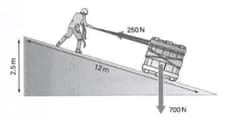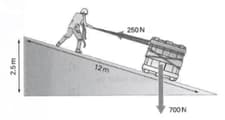Millie and Lily are identical twins who enjoy swimming. Their arms and legs provide the force needed to move them through the water. Millie can swim in . Lily can swim in .
Which twin has the greater power when swimming? Explain how you can tell.

Important Questions on Work and Power
Jim is pulling a load along a ramp, as shown. The diagram shows the force with which he pulls and the weight of the load.

Calculate the work done by Jim's pulling force.
Jim is pulling a load along a ramp, as shown. The diagram shows the force with which he pulls and the weight of the load.

What is the gain in potential energy of the load?
Two girls are estimating each other's power. One runs up some steps, and the other times her. Here are their results:
Height of one step
Number of steps
Mass of runner
Time taken
Calculate the runner's weight. (Acceleration due to gravity .)
Two girls are estimating each other's power. One runs up some steps, and the other times her. Here are their results:
Height of one step
Number of steps
Mass of runner
Time taken
Calculate the increase in the girl's gravitational potential energy as she runs up the steps.
Two girls are estimating each other's power. One runs up some steps, and the other times her. Here are their results:
Height of one step
Number of steps
Mass of runner
Time taken
Calculate her power. Give your answer in kilowatts .
A car of mass accelerates away from traffic lights. At the end of the first it has reached a speed of . During this time, its engine provides an average forward force of , and the average force of friction on the car is . Calculate the work done on the car by the force of its engine.
A car of mass accelerates away from traffic lights. At the end of the first it has reached a speed of . During this time, its engine provides an average forward force of , and the average force of friction on the car is .
Calculate the work done on the car by the force of its friction.
A car of mass accelerates away from traffic lights. At the end of the first it has reached a speed of . During this time, its engine provides an average forward force of , and the average force of friction on the car is .
Using k.e., calculate the increase in the car's kinetic energy at the end of the first .
